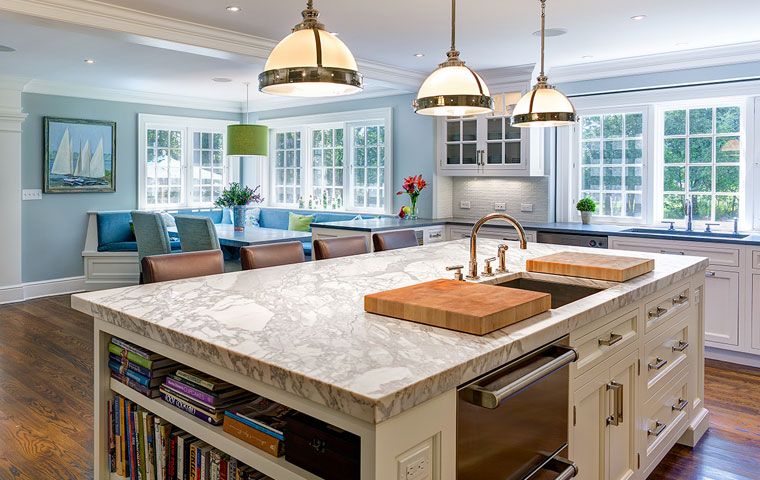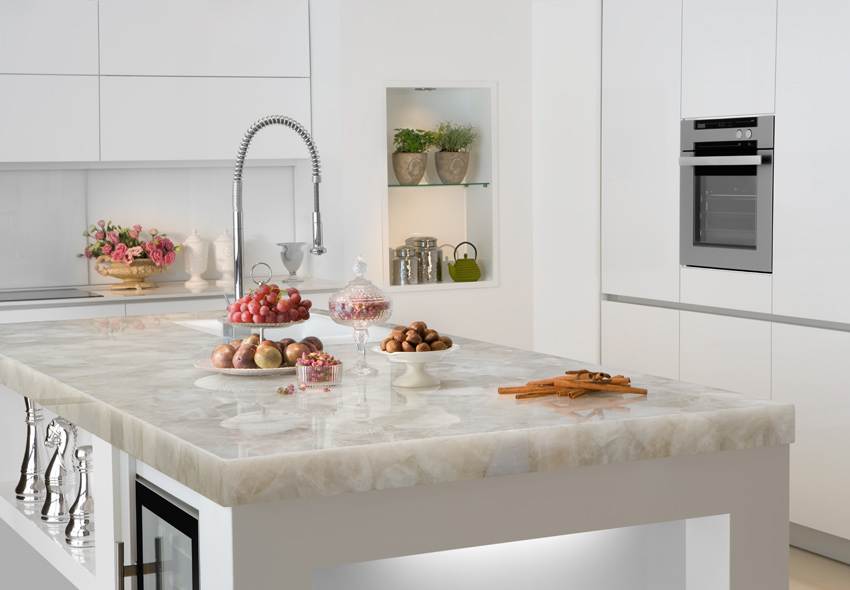Nothing spoils the sleek look of a quartz countertop faster than a stubborn coffee ring or a dried-on blob of tomato sauce. While quartz is far more stain-resistant than natural stone, pigments and oils can still cling to its resin binder if spills sit too long. This 1 000-plus-word guide explains, in detail, how to keep quartz spotless—from daily wipe-downs to deep-clean stain removal and professional resurfacing.
What Are Quartz Countertops?
Engineered quartz is a composite slab made from roughly 90–94 percent ground natural quartz mixed with polyester resins, pigments, and, in high-end lines, reflective chips or recycled glass. The resin fills the microscopic pores found in natural stone, creating a non-porous, food-safe surface that never needs sealing.
That built-in protection makes quartz more resistant to stains than granite or marble. However, resins can still absorb color if you leave red wine, curry, or permanent marker in place for hours—or worse, days. Understanding the material helps you pick cleaning products that lift stains without clouding the surface or degrading the resin binder.
How to Maintain and Clean Quartz Countertops
Regular care prevents most headaches. Follow these best practices before you ever reach for heavy-duty stain removers.
| Task | Frequency | Supplies |
| Wipe crumbs and water spots | Daily | Microfiber cloth + warm water |
| Degrease after cooking | As needed | Mild dish soap (pH-neutral) |
| Disinfect high-traffic zones | Weekly | 70 % isopropyl alcohol; spray and air-dry |
| Inspect for damage | Monthly | Flashlight + straightedge |
Important: Skip abrasive powders, bleach gels, paint thinners, and products containing hydrofluoric or phosphoric acid. They can etch or discolor quartz.
Daily Care Checklist
- Blot, don’t wipe. If you spill coffee, blot the puddle first so the liquid doesn’t spread.
- Use a soft sponge. Non-scratch cellulose or microfiber sponges lift food without marring the finish.
- Rinse well. Soap film leaves streaks; follow up with a water-damp cloth, then dry with a lint-free towel.
- Watch heat. Quartz can tolerate brief contact with hot pans, but repeated thermal shock may lead to resin discoloration. Always slide a trivet under cookware above 150 °F (65 °C).
How to Remove Tough Stains from Quartz Countertops
Even diligent homeowners face occasional stains. The best approach depends on the stain’s age, substance, and depth.
1. Using Mild Detergent — Small, Easy Stains
Ideal for: Fresh coffee drips, fruit juice, makeup smudges.
How to treat:
- Mix a few drops of pH-neutral dish soap in a cup of warm water.
- Dip a microfiber cloth, wring until damp—not dripping.
- Rub in tiny circles for 30–60 seconds.
- Rinse with clean water and dry.
If residue remains, repeat once more before moving to stronger solutions.
2. Using the Baking Soda Method — Tough Stains
Ideal for: Dried food, light turmeric spots, pen ink.
Why it works: Baking soda’s mild alkalinity loosens organic pigments without scratching quartz.
Step-by-step:
- Make a thick paste—3 parts baking soda to 1 part water.
- Spread ⅛-in. layer on the stain.
- Cover with plastic wrap and poke small holes for airflow.
- Let sit 30 minutes (up to 4 hours for stronger dyes).
- Scrape gently with a plastic putty knife, wipe clean, rinse, and dry.
3. Using a Poultice (Baking Soda + Hydrogen Peroxide) — Toughest Stains
Ideal for: Set-in wine stains, dried blood, permanent marker, hair dye.
Safety note: Wear gloves; hydrogen peroxide can lighten fabrics and irritate skin.
Instructions:
- Mix baking soda with just enough 3 % hydrogen peroxide to form a peanut-butter-thick paste.
- Apply a ¼-in. layer over the stain.
- Tape plastic wrap over the poultice to slow evaporation.
- Leave for 12–24 hours. The poultice draws pigment into the paste as it dries.
- Remove the plastic, scrape off the crusted poultice, and wash the surface with mild soap.
- Rinse thoroughly and buff dry.
Repeat once if faint color remains; deep chemical stains may require pro help (see below).
4. Extra Spot-Treatment Tricks
| Stain Type | Quick Fix | How-To |
| Grease splatter | Degreasing dish soap | Apply straight soap, let sit 5 min, scrub with non-scratch pad. |
| Hard water scale | 50/50 white vinegar & water | Spray, wait 10 min, rinse. (Use sparingly—don’t soak!) |
| Super-glue or nail polish | Acetone (fast wipe) | Dab with cotton ball; flush with water immediately. |
| Metal rust marks | Bar-Keeper’s Friend Soft Cleanser | Rub gently 10 sec; rinse thoroughly. |
How to Revive Your Quartz Countertops
Over time, quartz may lose its showroom sheen due to micro-scratches or detergent film. Bring back the luster with these steps:
- Deep clean first. Remove grease and mineral film using a pH-neutral stone cleaner.
- Non-abrasive polish. Use a specialty quartz polish or automotive rubbing compound labeled “non-scratch,” applied with a microfiber pad.
- Low-speed buff. If you own a random-orbit polisher, set it to 1 500–2 000 rpm and lightly buff the surface with a foam finishing pad. Keep the pad moving to avoid swirl marks.
- Final seal? Quartz does not need sealing, but applying a silicone-based stone polish can add water repellency and a short-term glossy boost.
Need Pro Services for Resurfacing Countertops?
If stains penetrate deep enough to cloud the resin binder—or if chips and thermal cracks appear—DIY fixes won’t fully restore the surface. A professional stone restoration company can:
- Micro-hone the top layer with diamond abrasives (200 → 800 → 1 500 grit) under controlled water flow.
- Color-match epoxy to fill chips or seams.
- Machine-polish to factory gloss using polishing compounds suited for engineered stone.
Expect costs of $200–$400 for a single vanity and $500–$900 for an average-size kitchen, depending on the extent of damage.
Final Tips and FAQs
Can I use bleach on quartz? Small, diluted amounts for disinfecting are generally safe if you rinse immediately. Extended exposure or gel bleaches can dull resin.
Does quartz stain permanently? Rarely. Most stains sit on or just below the surface and respond to poultices if treated promptly.
What about magic erasers? Melamine foam is slightly abrasive. Use lightly and only for marks that milder methods won’t budge.
How can I prevent future stains?
- Blot spills within minutes.
- Use cutting boards for foods with strong pigments (beets, turmeric).
- Keep coasters under iced tea and red wine glasses.
- Never place dye-laden cleaning rags directly on the counter.
Key Takeaways
- Daily habit: warm water + microfiber.
- Mild dish soap handles 90 % of messes.
- Baking soda paste conquers most remaining stains.
- Hydrogen-peroxide poultice tackles the worst offenders.
- Professional resurfacing is your rescue plan for deep damage.
Follow these steps and your quartz countertops will stay as bright and stain-free as the day they were installed—no matter what life (or cooking experiments) throws their way.


